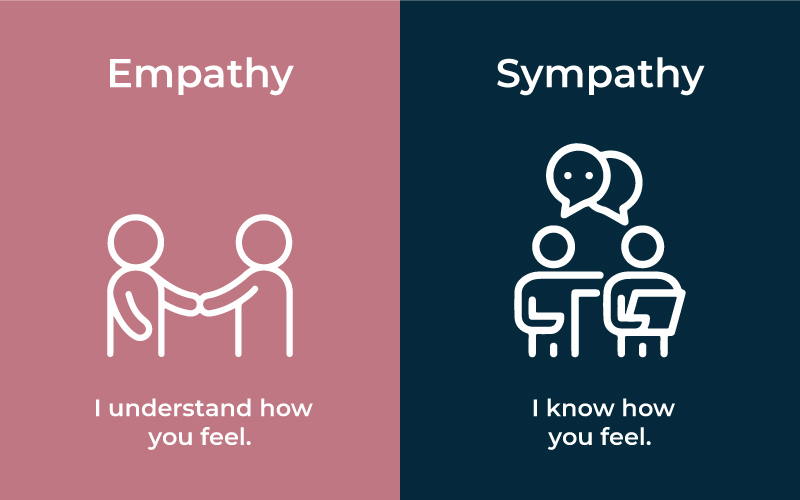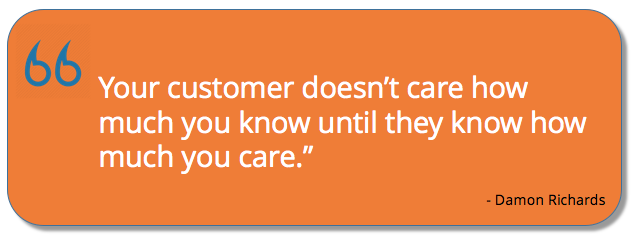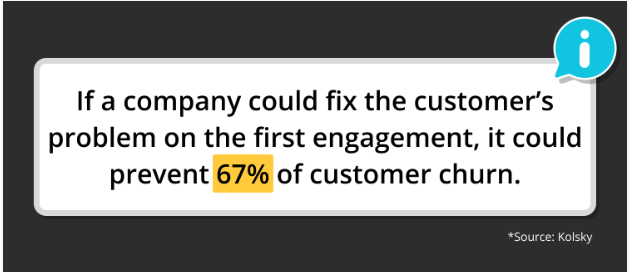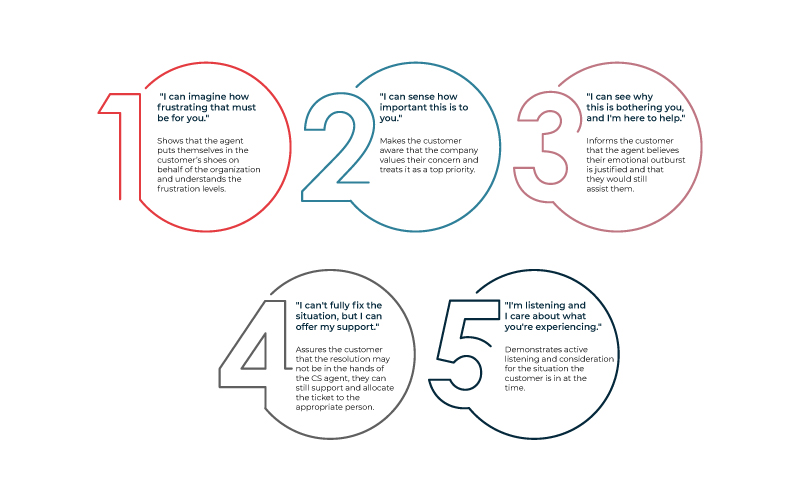Today, customer satisfaction is as crucial as ever. To provide a better experience to customers, companies need to empathize with their issues. When companies can genuinely connect with the intricacies of a customer’s journey, they can deliver more exceptional experiences. To start prioritizing customers throughout a company on a larger scale, the initial key is to fully comprehend the concept of empathy in customer service and how it can be used for good.

What is empathy in customer service?
Empathy is when you understand what the other person is feeling or going through. When it comes to businesses, that “other person” is your customer, and that “you” is the agent. Customer support is all about solving issues by understanding their state of mind, which is a step beyond simply looking at the surface.
The difference between sympathy and empathy becomes apparent in this situation. When you put yourself in a customer’s place and go above and beyond to address their challenges, you are demonstrating empathy. Sympathy is when you share the feelings of another.
Personalization is the first step in providing customers with an empathetic experience, and completely understanding them is the last. After all, customer service is all about people, and if you can successfully picture yourself in their shoes, you can help them more efficiently. Even if you are unable to address the problem, you may make the customer feel heard by displaying empathy, and acknowledging, and validating their sentiments.
Why empathy is essential for customer experience
A customer is looking for solutions when they call or raise a ticket. Customers also look for someone who can handle the venting of their emotions. If a customer support agent is not equipped to do that, the chances of retaining that customer are going to be next to zero.
When you’re aiming to forge deep and lasting bonds with your customers, empathy becomes the secret sauce. It’s about really getting into someone else’s shoes and feeling what they feel. This ability is like a superpower when it comes to crafting sturdy and unwavering connections with your customers.
It doesn’t matter if you’re the one steering the business ship, the friendly voice at customer service, or the creative mind behind marketing strategies – recognizing the pivotal role that empathy plays in customer relationships is your golden ticket to making heart-to-heart connections. These connections don’t just make your customers nod in approval; they leave a heartwarming mark that they won’t forget.
Empathy in customer service interactions would result in happier and more dedicated customers. The majority of customers buy from companies with which they have an emotional connection. Make empathy a key component of consumer communication and experience if you want recurring business as a result of brand affinity.
According to a study by the Harvard Business Review (subscription), “The top 10 companies in the Global Empathy Index 2015 increased in value by more than twice as much as the bottom 10 and generated 50% more earnings.” Businesses risk losing customers to competition if they don’t constantly show empathy or put themselves in the customers’ position.
Ways of building empathy in customer service

As Damon Richards says, “Your customer doesn’t care how much you know, until they know how much you care.”
In order to develop consumer empathy, it is crucial to start paying attention to your customer’s headspace. Customer service representatives must learn to empathize with others if they don’t naturally do so. Here are a few techniques for doing it:
Proactive listening:

Active listening is the first factor to take into account when planning customer empathy strategies. The first thing that agents are supposed to do when interacting with distressed consumers is to pay attention to what they have to say. As many avenues as you can for customers to communicate their problems and suggestions for solutions. Utilize social media, polls, reviews, and customer service interactions to actively seek out client feedback. Pay attention to all comments, positive and negative, as they can reveal important information about what customers value and what needs to be improved.
Personalized communication
Empathy requires addressing every customer’s unique issue in a hyper-personalized manner. Hyper-personalization is one step ahead of personalization. All organizational levels must work together to develop customer empathy. Businesses may develop enduring relationships with their customers and increase customer loyalty by actively listening to them, training staff, utilizing data and analytics, fostering a customer-centric culture, and personalizing the customer experience.
Empathy training
Empathy training for customer service teams is crucial for enhancing customer satisfaction and loyalty. Remember that empathy is a skill that takes time to develop and internalize. By providing comprehensive and ongoing empathy training, you can equip your customer service team with the tools they need to build strong connections with customers and deliver exceptional service.

Faster resolutions
67% of the churns can be prevented if the company resolves the issue at the first occurrence. Responding fast to customer queries makes all the difference in delivering outstanding customer service. There is no easier way to differentiate yourself from the competition than by improving your first response time. Resolving resolutions fast displays responsibility and care for customers and that is what customer empathy is all about.
Customer empathy is not something nice to have, it is a culture, and it can be easily developed with faster resolutions.
Leveraging data for a better understanding
Data and analytics can assist you in better understanding your consumers’ behavior, preferences, and problem areas. This data can be used to tailor their experience. Utilise numerous reports with over 1000 filters to monitor crucial metrics such as AHT, FCR, and CSAT and apply improvement initiatives. To better understand your consumers’ wants and how to improve their experience, use tools like customer journey mapping and customer satisfaction surveys.
Impact of Empathy on Customer Loyalty and Retention
Empathy has a profound impact on customer loyalty and retention. When customers feel understood, valued, and supported, they are more likely to develop strong emotional connections with a brand and remain loyal over time. Here’s how empathy influences customer loyalty and retention.
Builds Trust
Empathy is a key factor in building trust. When customers perceive that a company genuinely cares about their needs and concerns, they are more likely to trust the brand and its products or services. Trust is a cornerstone of customer loyalty.
Strong Emotional Connection
Empathy creates an emotional bond between the customer and the brand. When customers feel emotionally connected, they are less likely to switch to a competitor, even if a cheaper alternative is available.
Higher CSAT
Empathetic interactions lead to higher levels of customer satisfaction. Satisfied customers are more likely to spread positive word-of-mouth recommendations and reviews, which can attract new customers and enhance the loyalty of existing ones.
Reduced Customer Churn
Empathy addresses customer issues effectively, reducing the likelihood of customers leaving due to unresolved problems. When customers know their concerns will be addressed, they’re more inclined to stick around.
Word of Mouth and Referrals
Empathetic interactions create positive stories that customers are likely to share with friends, family, and colleagues. This organic word-of-mouth marketing can bring in new customers and strengthen loyalty among existing ones.
Higher CLTV
Loyal customers tend to spend more over their lifetime with a brand, as they are more willing to purchase additional products or services and are less price-sensitive.
Reduced CAC
Retaining existing customers is often more cost-effective than acquiring new ones. Empathy can help reduce the need for aggressive marketing campaigns to attract new customers.
Brand Advocacy
Empathetic customers are more likely to become brand advocates. They not only continue to do business with the brand but also actively promote it to their networks, contributing to brand growth.
Common empathy statements
Making empathic statements is one of the most crucial aspects of customer empathy. Because if you don’t demonstrate your organization’s customer empathy strategy to your customers, all of your work and thought would have been for nothing.
According to consumers, the top three qualities of a customer service agent are “willingness to help” (60%), “ability to solve my issue” (60%), and “knowledge about the product or service” (58%).
This shows businesses would essentially be losing about 60% of the chance of keeping a customer as their loyal one if the agents don’t display that they care enough about the customer to go above and beyond and have a “willingness to help”.
The customers should know that they are being cared for and they didn’t make a mistake choosing your product or brand.
Here are a few common statements that agents can use to display empathy in customer service:

Statement 1- “I can imagine how frustrating that must be for you.”
Explanation- Shows that the agent puts themselves in the customer’s shoes on behalf of the organization and understands the frustration levels.
Statement 2-“I can sense how important this is to you.”
Explanation- Makes the customer aware that the company values their concern and treats it as a top priority.
Statement 3- “I can see why this is bothering you, and I’m here to help.”
Explanation- Informs the customer that the agent believes their emotional outburst is justified and that they would still assist them.
Statement 4- “I can’t fully fix the situation, but I can offer my support.”
Explanation- Assures the customer that the resolution may not be in the hands of the CS agent, they can still support and allocate the ticket to the appropriate person.
Statement 5- “I’m listening and I care about what you’re experiencing.”
Explanation- Demonstrates active listening and consideration for the situation the customer is in at the time.
Delivering personalized customer experience at scale
Supporting a large customer base efficiently and effectively requires a combination of technology, processes, and strategies. There is a huge difference when it comes to enterprises and SMBs providing personalized experiences due to the scale of customers of both. Here are some of the best ways that can be utilized for delivering personalized CX at scale:
Omnichannel Support:
Empower agents to see all the customer queries from channels like email, calls, social media, website live chat, etc. on a unified dashboard and seamlessly manage all your customers.
Self-Serve Options:
Enable customers to troubleshoot issues and find answers on their own by developing a comprehensive knowledge base, FAQs, and tutorials.
Chatbots:
Implement chatbots to handle routine queries, provide instant responses, and free up agents’ time to work on more complex queries.
Data and analytics:
With Kapture CX, analyze data from deep reports with more than 1000+ filters to understand patterns and underlying issues to boost metrics like AHT, FCR, etc.
Feedback Loops:
Collect feedback from customers after interaction at different stages of the customer journey. Identify areas for improvement and optimize support processes. If you have systems like FeedbackPro in place, you can streamline your feedback processes easily!
Wrap-up
Until customers know that they are cared for and their pain points are understood, all technological and strategic investments will go in vain.
Providing support at scale is a continuous process of refinement. Regularly analyze performance metrics, gather customer feedback, and adapt your strategies to meet the evolving needs of your customer base.
Talk to our product squad: schedule a demo today!
,
,
,
,
,
,
,
,
,
,
,
,
,








